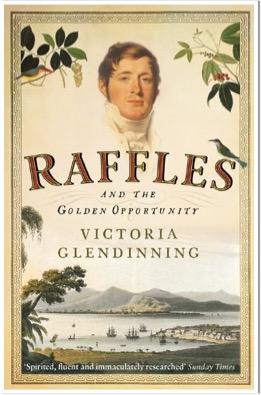Feb 2015 - Raffles and the Golden Opportunity - Victoria Glendinning
 |
Book Group 1
Raffles and the Golden Opportunity by Victoria Glendinning
And so began his infatuation with the East and his private dream of creating an Eastern Empire. His inquiring approach was reflected in his growing proficiency in Malay, his
|
|
growing proficiency in Malay, his burgeoning interest in all aspects of natural history and his appreciation of the surrounding cultures. His collections of drawings, specimens, historical documents and manuscripts grew. During this period the Napoleonic Wars in Europe meant that lands in the East frequently bounced back and forth between the Dutch and the English depending on the outcome of the latest war. In 1810 Raffles moved to Malacca as Agent to the Governor-General with the Malay States. While there, he connived with Lord Minto, Governor-General of Bengal to attack Batavia. After successfully sacking Batavia and gaining control of Dutch territory, Raffles was declared Lieutenant-General of Java. His time in Java was marred by questionable land sales, tax issues, territorial scandals, the passing of Lord Minto, and the death of his beloved Olivia in 1814. Charges were brought against him by the EIC, and the state of his health deteriorated gravely.
Raffles returned to England for the years 1816 to 1817, allowing him time to recover, salvage his reputation, publish his book, The History of Java, marry his second wife, Sophia, who loved him deeply and be knighted Sir Stamford Raffles. His rehabilitation in the eyes of the EIC was complete when it was announced that he would be appointed Lieutenant-Governor at Bencoolen, on the west coast of Sumatra.
In 1818, he and Sophia arrived at Bencoolen and set up their home on “their Hill”. With concessions to the Dutch, only Penang and Bencoolen were left in British hands and their trade was threatened. The EIC realized they needed to acquire a modest trading post south of Malacca to stay competitive. Raffles agreed that Major William Farquhar should investigate the islands off Johore. The two men and their squadron anchored off shore of the island of Singapore in January 1819 with his golden opportunity within reach. On February 6 a treaty was signed with Sultan Hussein Shah, promising him “five thousand Spanish dollars a year and the protection of the British. In return the British government was granted exclusive rights to establish a settlement or ‘trading factory’ on the island. It was not a conquest … more like a leasehold purchase.” Nine days later Raffles sailed away, leaving Farquhar as Resident and Commandant under his Government at Bencoolen.
Raffles was not to return till October 1822, two and a half years later. He found his “almost only child (Singapore) had … grown and advanced beyond measure.” Although the city had blossomed under Farquhar, the two men soon became embroiled in an on-going slinging match covering all sorts of petty matters. Raffles countermanded many of Farquhar’s policies but he did establish the Raffles Institution. Terrible headaches began to beset him and Raffles was urged to return to England, where he arrived in 1824, after only nine months in Singapore.
Once back in England, Raffles established a Zoological Society, the precursor to the London Zoo. The EIC presented him with an invoice for almost £23,000 being payment of his salary claimed while he was in England previously. Seriously in debt, he died in 1826. His second wife, Sophia, wrote a memoir of his life, which cemented his accomplishments in the public’s mind.
Our group appreciated the research that Glendinning must have undertaken to come up with such a detailed biography of the founder of Singapore, but found the many personalities referred to and the time details confusing. It gave us a more balanced view of Raffles, giving us insight into his many sacrifices (four of his children died while he was in Asia) and his difficult nature (squabbles with many colleagues and only informing his superiors of his actions after the fact). It was a noble effort at profiling an enduring name in Asian history.
Submitted by Leslie Muri
|
|




